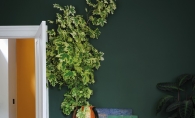
From scrapbooking and knitting to woodworking or fixing cars, homeowner hobbies are part of what makes us tick. Dedicating a space in your home for your passion is a great way to find more time to do what you love.
“I love creating these spaces from the ground up so that you have a spot for everything,” says interior designer Amy Leferink, owner of Interior Impressions. “You can make it look beautiful if it stays cleans and tidy. You know where things are; that’s the key. That helps you be more productive. If you spend half your time just looking for your stuff, you don’t feel as motivated.”
Leferink has designed “man caves” and “she sheds” and spaces for hobbies such as jewelry making and scrapbooking. She’s also helped make spaces multifunctional, such as a laundry room that doubles as a kids’ craft space. “When a client is building or remodeling a home, you really make sure that you tailor that home around what their needs are now, but also down the road,” she says. “It’s always interesting to find out what people do in their downtime.”
Recently Leferink helped two Woodbury clients design and decorate spaces for their passions in their new homes, both built by Custom One Homes, making these spaces both fun and functional.
Tee Time
For Paul and Gloria Parnell, having entertainment space for friends and family was important. They love wine and sports, especially golf. And the opportunity to build
a custom home meant the chance to create a unique feature to help Paul have more time for the sport he loves.
The Parnells have four children, ranging in ages from 2 through 13, so between running a business and a very busy family life, Paul says that finding time for golf in the season isn’t easy. “If you go play golf, it’s
a four- to five-hour commitment. With this unique space in our home, if I only have time for a couple of holes at 8:30 at night after the kids go to bed, I can golf,” says Paul, who has been playing golf since he was a teenager. “And when it’s 20 below in January, it’s also nice.”
The lower level of the Parnells’ home has a room dedicated to a golf simulator, where Paul can swing, chip and putt with a real ball and club, playing on a course such as the famed Pebble Beach, all from the comfort of his own home.
The back wall is a heavy duty screen where the course is projected, managed by a computer system with over 28 different courses and driving ranges. The system also gives stats like ball speeds and distance to help Paul improve his game. “Tom Rauscher and Associates was the architect and did the design plan,” says Leferink, who was brought on after the build to decorate the Parnell home. “They designed the space with a counter and barstools so people can sit, have a beer and watch who is playing golf. It was well-designed to be a group-oriented space.”
“I’m not a golfer, but the way this is set up with the seats, I can be engaged with them and watch them play,” Gloria says. “Our two older boys are playing golf, so it’s something really nice they can do as a family too,” she says, noting that the kids know this isn’t a toy for them to play unsupervised.
Leferink added some fun golf artwork and sculptures to complete the space, which is part of a larger entertainment area that has a sports bar, theater room and wine room.
“I had my 90-year-old grandma here; she’d never played golf before and it was so fun to see her play,” Paul says. “When would I be able to take my 90-year-old grandmother out to the golf course? But she was able to swing a club for the first time ever here.”
Home Brewed
Twenty years ago, Dr. Jack Skendzel started brewing beer from a kit in his college dorm room. Over the years, he has perfected his craft, taking great pride in making beer for friends and family to enjoy.
Today, Jack is an orthopedic surgeon and his wife, Sasha, is an oncology nurse. So when it came time for the couple to build a new home, it was important to find a dedicated spot for Jack’s hobby, and space to unwind from their hectic careers. “I was brewing in the garage before and it was so cold in the winter. We didn’t have a heated garage,” says Jack, who explained his previous system used combustion with propane and flame.
His new high-tech electric brewing equipment includes special venting incorporated within the architecture of the home during the build, which Leferink was involved with since the blueprint phase. “It’s like a hot water heater, so there is no gas, no flame—it’s very safe,” Jack says. “It’s nice that I have everything here and it’s all in one room. I’d have made it even bigger in hindsight.”
“It’s also less private outside; you have neighbors wondering what’s going on,” Sasha says. “Now Jack has more privacy and everything is much more temperature-controlled. It’s a science, and this way he can get the exact temperature and PH and everything with this system.”
The home brewery flooring is a luxury vinyl that looks like wood, but is water resistant. White subway tile gives that industrial feel, and is easy to clean, and stainless steel shelving and counters not only look good, but are food-safe. Jack also has airtight storage for his different grains.
Fun details like a chalkboard wall allow Jack to write his recipes and formulas. The space can be closed off with barn doors inset with glass so you can still see inside, and the family can be around while Jack enjoys his hobby. “I designed the space to have a ‘North Loop/North Minneapolis’ vibe of a microbrewery, with fun industrial design that was also practical and functional for brewing beer,” Leferink says.
Jack brews into 5-gallon kegs, which he can put on tap in a built-in kegorator at the bar, which holds his collection of microbrewery glasses and growlers. He had custom taps made for his craft labeled “Autumn Ridge Brewing” in honor of his new neighborhood.
The Skendzels recently had their first child, Brady, who can sit in his bouncy seat and watch dad during a brew session. Their dog, Pablo, likes to help too and makes an appearance on the tap label. “I can brew everything—sour, stout, pale ale, German, Belgian, anything. I do a lot of German styles; Pilsner or Helles are all very light beers. You don’t always want a heavy beer at the end of the day,” Jack says. “We can’t sell it, but we give a lot away as gifts and in the summer when people come over to use the pool, we go through a lot.”
Tips for Creating a Hobby Space
As people spend more time in their homes, and more people are working from home at least part of the time, it’s becoming especially important to incorporate some space with flexibility. Here are a few tips from Amy Leferink for creating your own hobby space.
• Find unique storage solutions. Try an antique hutch to add some character or a coffee table with storage. You can hide and tuck things away, but it still looks great.
• A rustic farm style table in the room will wear well for crafts.
• If you don’t have an entire room, create a zone with a special chair and end table with storage where you can put supplies.
• When you’re building or remodeling, try to transform a space to make it more functional, giving you a spot to do what you love to do.









